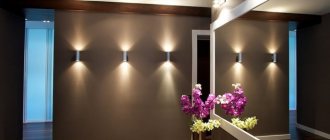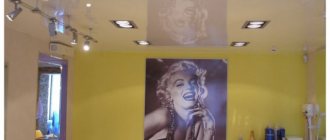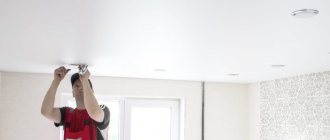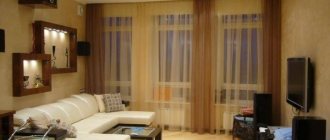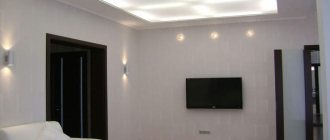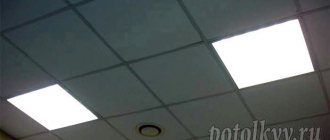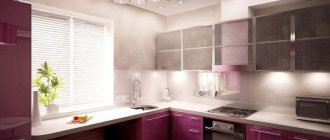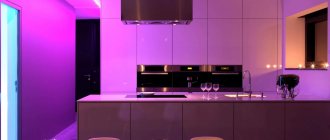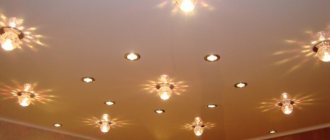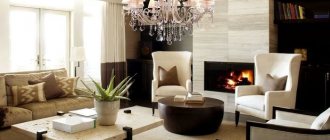Spotlights (another name is spots) have become a characteristic detail of modern rooms. Sometimes they are used to organize main or background lighting, sometimes their role is to provide detail, to draw attention to the front of a cabinet or a picture on the wall. Spot lighting in the interior is a great opportunity to make rooms stylish and cozy.
Location of lamps around the perimeter Source cms.giadinhtre.vn
Device features and benefits of use
Spotlights got their name due to the small size of the lamp and the external effect of radiation from a single point. The lamp is enclosed in a shade; hence the main feature of the spots: the light dispersion angle does not exceed 30°, and the light flux itself has the shape of a cone.
A small angle allows you to illuminate a limited part of the space, so for uniform lighting, use a group of spots with a fairly dense arrangement. The steady demand for spot lighting is explained by the following benefits of use:
- Spots are practically invisible and therefore adapt to any interior. Small ceiling lamps are hidden under the surface when installed and therefore do not burden the space.
Almost invisible in the interior Source www.pinterest.fr
- You can choose spots for any style. Some models allow you to adjust the direction of the light, which increases their design capabilities.
- You can evenly illuminate any room. A chandelier does not always cope with this task, but well-placed spots on the ceiling will easily solve the problem.
- You can organize partial lighting of the room, and thereby significantly save electricity.
Kitchen accent lighting Source pixelarttutorial.com
Ceiling options
The placement of spotlights needs to be thought out in advance, especially if a suspended ceiling is to be installed.
The backlight can be located either symmetrically or in a chaotic manner.
Light sources built into a multi-level suspended or suspended ceiling will allow you to create a unique interior, highlight the architecture and atmosphere of the room.
The lighting will be uniform and of the highest quality if the devices are installed so that the rays of the light flux intersect above all elements in the room.
The best option is built-in spotlights along the perimeter of the ceiling plane. They can be switched on together with a central chandelier to create more intense lighting.
The parallel arrangement of lamps in several rows will help to achieve proper comfort in the room.
A cross-shaped arrangement of light sources will fit perfectly into a small room with a low ceiling. The corner space is equipped with single models, and a gimbal structure is installed in the center.
Also, for a small room, the arrangement of lamps in the form of a square is appropriate.
In order to illuminate a certain area, an arc-shaped arrangement of lighting fixtures is used. Thanks to this technique, it is possible to soften the strict interior.
Some rooms require the installation of light sources in a checkerboard pattern. For example, a similar solution is often found in the design of an island-type kitchen, where good lighting of all zones is required.
Types of spotlights
If we talk about appearance, then, in addition to round ones, there are models of square, oval and non-standard shapes. It is convenient to classify spotlights according to the place of attachment:
- Built-in. Such lighting fixtures decorate suspended and suspended ceilings, walls and stairs. They require lamps with a minimum heating level so as not to damage the base.
Recessed spotlights Source pegasus-pro.si
- Invoices (external). There are wall and ceiling; the structure is fixed with screws, the light flow is distributed by the diffuser of the outer housing.
The larger the model, the lower the ceiling appears Source www.zumaline.ru
- Furniture. Mortise and overlay spot models help illuminate furniture fronts, work surfaces, as well as the interior space of shelves and drawers.
Shelf lighting Source imarket.by
- Hanging. Such spotlights take up more space in the interior, since installation is carried out on special mounts, and the device remains visible. Many hanging models are equipped with a rotating mechanism.
Suspended spots in the bedroom interior Source amazon.fr
Built-in ceiling models, in turn, differ in the type of installation:
- Models for installation in rigid suspended structures (plasterboard, plastic panels, slatted ceilings); equipped with two fastening clips.
- Models for suspended ceilings. In this case, installation is carried out using special brackets before the canvas is tensioned.
On a suspended ceiling Source kmr-82.ru
See also: Catalog of companies that specialize in designing and performing lighting work of any complexity
Options for suspended ceilings
There are no secrets when it comes to lighting suspended ceilings. It is important to choose the right lamps. The lamps are positioned similarly to ceilings made of plasterboard structures. You need to select lamps based on the ceiling material.
For example, you should not use traditional incandescent lamps together with PVC film - they are too hot, modern fabric allows lamps less than 60 W, but no more.
If there is no central lighting in the room, then the installation of more powerful lamps with the ability to rotate will be required. You can get harmonious lighting by choosing a tone.
To be able to adjust the brightness, experts advise installing a dimmer. It is an adjustable device - you can create a dim, pleasant light or a bright glow.
Above or at ceiling level
This category includes lamps for suspended ceilings. Their peculiarity is that the glow is emitted directly from the ceiling. It looks very, very impressive. However, there are disadvantages. Thus, the efficiency of the light is not fully utilized; a significant part of the glow will fall above the level of the ceiling structure.
Due to the fact that there is no flow of fresh air between the base and suspended ceilings, the lamp and luminaire heat up. It is better to use LED lamps, they do not heat up to high temperatures.
Below ceiling level
These below-ceiling solutions feature maximum dispersion. But there are problems with power and current. So, the light bulb has a power limit of less than 35 W. The voltage is below 220 V, which means a transformer must be used.
Other options
You can also highlight overhead lamps. Installing them is more difficult - you need to prepare the ceiling surface. But there is much more choice. The advantage of such models is that they can accommodate light bulbs of any type.
Types of lamps
The choice of lamps for spotlights is also worth paying attention to, since they differ in characteristics, operating features and directly affect the quality of lighting. The number of lamps used for spots includes the following types:
- Incandescent lamps. They get very hot and can damage surrounding materials, so in built-in spots only models with a mirror reflector and a power not exceeding 60 W are used. These products are cheaper than others, but consume more electricity, and they have to be replaced more often (at best, after 1000 hours of operation).
The quality of lighting depends on the characteristics of the model Source miniledpanel.hu
- Halogen. They heat up quite strongly, which limits their scope of application; In addition, they are sensitive to voltage changes. In order for halogen lamps to work the declared service life (more than 2000 hours), you will need a protection unit - a soft starter.
Halogen lamp Source www.market-sveta.ru
- Luminescent (CFL). The main advantage is economical energy consumption. The lamp provides even, white illumination, but contains mercury and therefore requires extremely careful handling.
On a shelf in the bathroom Source ch.paulmann.com
- LED. The most practical products: do not heat up, consume energy sparingly, shine brightly, and are safe to use. The service life of different models extends to several tens of thousands of hours, so replacing numerous lamps on a suspended ceiling (a labor-intensive process) will be a rare task. Reliability and other advantages compensate for the high cost of the products.
LED rotary Source obi.ru
See also: Catalog of companies that offer the service of selection and installation of any electrical appliances or electrical equipment in general
Scope of application and choice of location
Ceiling lamps in the interior have a wide range of design possibilities, including the following methods of use:
- Arrangement of light accents. The spots beautifully illuminate the multi-level ceiling, furniture, paintings, steps of the stairs, and the pool.
Accents on opposite walls Source gastronomiayviajes.com
- Zoning of space. It is convenient to highlight, for example, the dining area in the living room with light. The device can be installed above a sofa or armchair.
Selecting a working surface Source extremesurvival.info
- Imitation of the starry sky.
- Possibility of dimming (smooth brightness adjustment). Creates an atmospheric (solemn or intimate) atmosphere depending on the time of day or mood.
In the nursery Source pinterest.com
In different rooms, spotlights are used in different ways:
- Living room. Spots are used functionally: as local lighting or instead of a chandelier. In the first case, they are placed around the perimeter of the room, in the second, they are distributed evenly along the ceiling, in rows or in a circle.
Main light source Source m.yukle.mobi
- Bedroom. In a room intended for relaxation, bright, flooding light is useless. Therefore, white spots with frosted glass are installed here.
Comfortable environment Source laceainarie.com
- Kitchen. You can’t do without high-quality lighting here. In addition to stationary ones, it is a good idea to install lamps with a rotating mechanism in the kitchen, perhaps a pair model.
In a white kitchen Source ankaramutfakdekor.com
- Entrance hall (corridor). In a modest-sized room, spotlights do an excellent job as the main light source. They are mounted in one or two rows along the ceiling.
In a square corridor Source mblx.ru
- Bathroom. For wet rooms, choose waterproof models that are safe to use.
Spotlights in the bathroom Source santeh777.ru
Photos in the interior of the rooms
Features of installing lamps in the interior of specific premises.
Spotlights in the kitchen
The kitchen space requires a lot of light. It is advisable to install several devices with a bright and soft light flux. In this way, you will learn how to create enough lighting in the kitchen and at the same time achieve a pleasant environment.
If there is not enough free space, you can equip the kitchen wall cabinets with lighting.
Spot lighting in the kitchen in combination with an LED strip of different colors will add even more originality to the design.
Spotlights in the living room interior
In the interior of a living room with a ceiling chandelier, it is better to install light sources with low power. Thus, when the chandelier is turned off, a pleasant, soft and muted glow will emanate from the lamps
. In this case, point devices can be placed only on one side of the ceiling.
For a hall without a central chandelier, almost any arrangement of light sources is suitable, for example, in the form of a circle, square, oval or even a diamond.
Examples in the interior of the corridor
Typically, the design of a hallway assumes the most simple arrangement of lighting fixtures. For a narrow corridor, one row of 3 or 5 point lamps is suitable. In a square room, it is appropriate to install two rows consisting of 3 or 4 light bulbs.
Spot lighting in the bedroom
Perimeter lighting will look great here. A good solution is to install a multi-level stretch ceiling, decorated with dim lighting.
LED strip mounted on the sides of the ceiling plane will complement spotlights advantageously.
Thanks to light sources, the bedroom can additionally be divided into an area with a bed, dressing table or wardrobe.
How many spots are needed and how to place them
To determine the optimal number of spotlights (if you mean main lighting), there is a special formula, but the calculation can be done in a simpler way. To do this, the following calculations are carried out:
- The total number of watts per room is determined. The area of the room is multiplied by the number of Watts required by lighting standards per 1 m2. According to SNIP, the lighting level for a bedroom is 12 W/m2, for a nursery - 15 W/m2, for a living room - 20 W/m2.
- To determine the minimum number of lamps, the total number of Watts is divided by the power of the selected lamp.
You may need a lot of lamps Source legkovmeste.ru
- Inverse problem: to determine the power of one lamp, the total number of Watts is divided by the number of lamps.
Spotlights are installed taking into account the following conditions:
- The distance to the wall must be at least 70 cm.
- To determine the distance between lamps, the length of the wall is divided by the number of spots.
- To determine the distance of the lamps from the wall, half the length of the wall is divided by 2.
Placement in two rows Source pinterest.com
How to choose
An important criterion when choosing lamps in the interior is their design, which is consistent with the style of the room. For a classic room, you can choose models with ornaments or crystal pendants. In a room with a modern design (modern, high-tech, loft) standard white lamps of a simple shape are suitable. In addition to the appearance and material of the lampshade (it can be glass or acrylic), when choosing, pay attention to the following details:
- Design. If the ability to change the angle of light is important, pay attention to rotating lamps.
In a modern interior Source leporte.net
- Base type (usually GU10 or LED).
- Dust and moisture protection class. Important when installing in a bathroom, open veranda or kitchen.
- Possibility of changing the type of lamp (LED instead of halogen).
- Possibility of connecting a dimmer.
In the dining area Source midway1942.org
